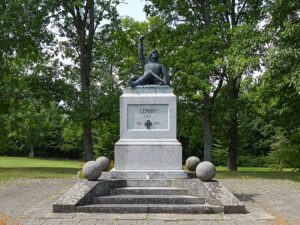In the thirteenth century, the German Livonian Brothers of the Sword entered the lands we now call Estonia as part of the medieval crusades. Lembitu was part of the Estonian resistance to the German invasion. According to some sources, he was a leader of a small area in what is today Southern Estonia.
Until this time, most of Estonia consisted of small settlements that were not part of a nation-state. With a core common language that contained regional distinctions, the pagan Estonians lacked a centralized government.
Lembitu lead many men in battle against the Germans. In September 1217, Lembitu was killed at the Battle of Matthew’s Day.
Thus began approximately seven-hundred years of occupation of Estonia. I will save that history for another blog post, but in the meantime, Lembitu took on mythic characteristics. In 1918, Estonia was ruled by Imperial Russia and declared it’s independence in true David and Goliath battle against not only Russia, but Germany as well. In this heady new world where the Estonian War of Independence was raging, many young men were named after this Estonian hero.
Thus, when my father was born in 1918, my grandparents named him Lembit. I never knew my grandparents, but I can imagine that naming their youngest son after Estonia’s national hero was an act of hope and bravery as in 1918, there was no guarantee that Estonia would be able to secure independence from Russia. The actual peace treaty wasn’t signed until early 1920.

By Vaido Otsar – Own work, CC BY-SA 4.0, Wikimedia Commons
But the story doesn’t end there. Today in Estonia there are a plethora of streets named Lembitu, a Lembitu park in Tallinn, and even a hotel named Lembitu. There is a monument to Lembitu in Suure-Jaani, bus stops named Lembitu, and even the EML Lembit, a pre-World War II mine-laying submarine.
Finally, rumor has it that Lembitu’s skull is in a museum in Poland. With Estonian and Polish government support, the hunt is on for the missing skull of Lembitu.
This saga, which started almost 800 years ago, is continuing to unfold as a living breathing part of Estonian history and/or mythology, depending on how you see it.